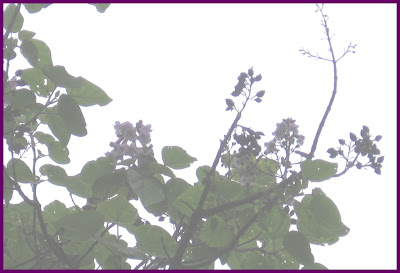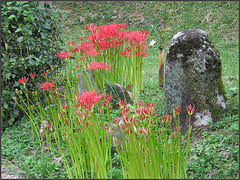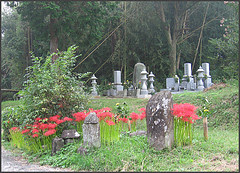桐の花 雨上がりの 霧に消え

mist merges
with heavy rainclouds -
paulownia flowers

after the storm -
paulownia blossoms
in each puddle
|
:::::::::::::::::::::::::::::::::::::::::::::::::::::::::::::::::::::::::::::::::::::::::::::::::::::
桐の花 見上げて空の笑顔かな
paulownia buds -
and then looking up
to the smiling sky
kigo for early summer
paulownia flowers, kiri no hana 桐の花
..... hanakiri 花桐(はなきり)
The trees grow stright to a great hight, and the flowers are right in the four directions high up there. They convey a sense of straightness. In haiku, looking up at the flowers is often a theme.
aburagiri no hana 油桐の花 (あぶらぎりのはな)
flowers of Japanese tungoil tree
yamagiri 山桐(やまぎり)"mountain paulownia"
dokue、どくえ、inugiri ぬぎり
Aleurites cordata, Vernicia cordata
:::::::::::::::::::::::::::::::::::::::::::::::::::::::::::::::::::::::::::::::::::::::::::::::::::::
Paulownia is a genus of between 6–17 species (depending on taxonomic authority) of plants in the monogeneric family Paulowniaceae, related to and sometimes included in the Scrophulariaceae. They are native to much of China (its name in Chinese is 泡桐/pao1 tong2), south to northern Laos and Vietnam, and long cultivated elsewhere in eastern Asia, notably in Japan and Korea. They are deciduous trees 10–25 m tall, with large leaves 15–40 cm across, arranged in opposite pairs on the stem.
The flowers are produced in early spring on panicles 10–30 cm long, with a tubular purple corolla resembling a foxglove flower.
The fruit is a dry capsule, containing thousands of minute seeds.
Paulownia is known in Japanese as kiri (桐), specifically referring to
P. tomentosa; it is also known as the "
princess tree". It was once customary to plant a Paulownia tree when a baby girl was born, and then to make it into a dresser as a wedding present when she gets married. It is the badge of the government of Japan (vis-à-vis the chrysanthemum being the Imperial Seal of Japan). It is one of the suits in hanafuda, associated with the month of December. Japan: An Illustrated Encyclopedia states:
The genus was named in honour of
Queen Anna Pavlovna of The Netherlands (1795–1865), daughter of Tsar Paul I of Russia.
Paulownia wood is very light, fine-grained, soft, and warp-resistant and is used for chests, boxes, and clogs (geta). The wood is burned to make charcoal for sketching and powder for fireworks, the bark is made into a dye, and the leaves are used in vermicide preparations.
© Wikipedia
Some other types of paulownia in Japan
aogiri アオギリ【青桐、梧桐】
akigiri アキギリ【秋桐】
aburagiri アブラギリ【油桐】
iigiri イイギリ【飯桐、椅】
harigiri ハリギリ【針桐】
higiri ヒギリ【緋桐】
.............................................
"autumn of the paulownia, dooshuu 桐秋(とうしゅう)
kigo for early autumn
Category : Season
 kiri hitoha 桐一葉 (きりひとは) one paulownia leaf
kiri hitoha 桐一葉 (きりひとは) one paulownia leaf
..... hitoha, hito ha 一葉(ひとは)one leaf
..... ichiyo
hitoha otsu 一葉落つ(ひとはおつ)one leaf falls
hitoha no aki 一葉の秋(ひとはのあき)autumn of one leaf
kiri no aki 桐の秋(きりのあき)paulownia in autumn
(Some saijiki place this kigo in early winter).
 桐一葉落ちて天下の秋を知る
桐一葉落ちて天下の秋を知る
kiri hitoha ochite tenka no aki o shiru
one paulownia leaf
has fallen - now we know
the heavenly autumn is coming
Ichi yo ochite tenka-no aki-wo shiru
(With the fall of one we know that autumn as come to the country.
When one leaf has fallen, it is known that autumn is coming.
A single leaf flutters in the air and it's autumn.)
Katagiri Katsumoto 片桐且元 (1556 - 1615)
He was a retainer of Toyoyomi Hideyoshi.
He was driven in exile just before the Battle of Osaka, when he then wrote this haiku.
source : tenkomori.tv
.............................................................................
Basho writes to his friend Ransetsu:
さびしさを問てくれぬか桐一葉
sabishisa o toote kurenu ka kiri hitoha
A paulownia leaf has fallen :
Will you not come to me
In my loneliness?
Matsuo Basho
source : Emily Evans
Will you not call on me in my loneliness?
A paulownia leaf has fallen.
A paulownia leaf has fallen in my garden, and lonesomeness overwhelmes me.
Will you please come and see me, my dear friend?
Classic Haiku:
An Anthology of Poems by Basho and His Followers
source : books.google.co.jp
A paulonia leaf has fallen;
Will you not visit
My loneliness?
source : 王貞治さん
cette solitude
viendrais-tu la partager ?
feuille de paulownia
source : nekojita.free.fr
よるべをいつ一葉に虫の旅寝して
yorube o itsu hitoha ni mushi no tabine kana
. Matsuo Basho 松尾芭蕉 - Archives of the WKD .
:::::::::::::::::::::::::::::::::::::::::::::::::::::::::::::::::::::::::::::::::::::::::::::::::::::::::::::::::::::::::::::::::::
きり一葉二は三は四はせはしなや
kiri hito ha futa ha mi ha yo ha sewashina ya
one paulownia leaf
and two, three, four -
how busily bustling
Kobayashi Issa
sewashinai 忙しない
. Numbers used in Kigo .
Tr. and comment by Chris Drake
kiri hito ha futa ha mi ha yo ha sewashina ya
a paulownia leaf falls,
a second, a third, a fourth --
what's the big hurry?
This hokku is from the beginning of the 7th month (August, early September), the first month of lunar autumn. In it Issa plays on an ancient Chinese saying which became a kigo season phrase in Japanese.
In the ancient Chinese anthology of philosophical writings known as
Huainanzi (139 BCE, in Japanese Enanji), the phrase "knowing autumn has come by seeing a single Paulownia leaf fall" is a metaphorical expression meaning "recognizing a big change is coming before it comes by noticing a tiny change."
This Daoist approach took on a more Buddhist tone when the phrase was read in translation in Japan, where it was mostly used to mean "seeing a paulownia leaf fall and recognizing that all flourishing things soon decay and die." As a kigo in haikai, the literal meaning of seeing a paulownia leaf flutter down is stressed, and the phrase indicates that lunar autumn has almost imperceptibly just begun.
Paulownia leaves are heavy and very large (often the size of a hand-held fan or larger), and they fall earlier than most leaves, so the phrase is literally an image of autumn just beginning. Thus Issa's diary for the 7th month of 1812 has several hokku about paulownia leaves falling at the very beginning of the month, when there are few other signs that autumn has already begun. However, Issa goes beyond the standard image and evokes a second large leaf falling, followed by a third, and then a fourth. The second line sounds like someone welcoming the leaves to the ground by singing a song out loud, and Issa's reaction to the small profusion of leaves is humorous, but at the same time there is a suggestion of the deeper meaning of the original saying: if a single paulownia leaf foretells big changes in the near future, then four leaves must mean that the changes will be really big -- and they may be coming very soon.
Issa may well be thinking of Buddhism and the Pure land here as well. Four leaves falling instead of one is a very clear reminder that all things constantly and often unexpectedly change and that death and life are inseparable. Four falling leaves, then, might give Issa a sudden gut feeling of how near the Pure Land is. In fact, placed a few hokku earlier in Issa's diary are these two hokku:
nembutsu ni byoo no tsukishi hitoha kana
a single leaf
falls to the rhythm
of Buddha-name chanting
kiri hitoha totemo no koto ni saihoo e
a paulownia leaf
gives itself utterly
toward the west
In the first hokku, a leaf uncannily leaves life and falls as if in harmony with someone chanting Amida's name, and in the second hokku, Issa seems certain that leaves can go to the Pure Land in the west just as fully as humans can. In this second hokku Issa seems to regard the leaf as a teacher and comrade who is demonstrating to him how to be brave and resolute and all-trusting in Amida as it leaves its limb.
With these last two hokku in mind, its seems possible that in the very first hokku above about the four leaves falling Issa may also be referring to the sound of "four" (shi), which is the same as the sound of the word for "death" (shi).
The fact that the two words are homonyms has made the number four a taboo word in certain ritual contexts in Japanese, although Issa joyously uses it, perhaps because it reminds him of the Pure Land. Issa's advice in the last line to the leaves to slow down seems to be both a humorous expression of friendship and sympathy with the leaves and a realistic recognition that time never stops. Issa is probably addressing himself as well and telling himself to relax and follow the rhythm of time created by his own relationship with Amida.
The discussion continues here:
見一葉落,而知歲之將暮
knowing the end of the year approaches its very end by seeing a leaf fall
. Translating Issa .
- - - - -
涼しさのたらぬ所へ一葉哉
suzushisa no taranu tokoro e hito ha kana
into a place
lacking coolness
a paulownia leaf
Tr. Chris Drake
The date of this early autumn hokku is unknown, though the time of the hokku is probably late August or early September. It's in a collection of hokku Issa sent to the Edo poet Seibi, who returned them with his evaluations, so it was probably written between 1812 and 1816.
The first fallen paulownia leaf of the season was regarded as very significant, since traditionally it was believed to mark the clear, undeniable beginning of autumn and the end of summer-like early autumn days. The hokku seems to be about a village or town or a part of one which still seems to be in late summer. It's warm there, and it "lacks" the coolness of true autumn. As if to remind the people here that time is actually passing, a single large, roughly heart-shaped paulownia leaf now lies on the ground.
The phrase "knowing autumn has come from a single fallen leaf" goes back to ancient China (see the 11/7/2012 post), and the first fallen paulownia leaf often has somber or even ominous overtones in Japanese literature. In this hokku the paulownia leaf seems to be an image suggesting time itself and inevitable change and decline, abstractions which have suddenly become all too visible and poignant through the appearance of the leaf. Perhaps Issa is also suggesting that no matter where paulownia leaves fall the weather always feels unrealistically warm and the people there are always trying to live in an illusory timeless bubble, since that is the human condition. Amida Buddha may well be in the background of this hokku.
Chris Drake
. Kobayashi Issa 小林一茶 in Edo .
.............................................................................
.............................................................................
kigo for early autumn
kiri no mi 桐の実 (きりのみ) paulownia nut
. . . CLICK here for Photos !
.................................................................................
kigo for late autumn
aburagiri no mi 油桐の実 (あぶらぎりのみ)nut of the Aleurites cordata
..... toyu no mi 桐油の実(とゆのみ)
Aleurites cordata. Tungbaum
It is used to make oil.
iigiri no mi 飯桐の実 (いいぎりのみ ) nut of the Iigiri
Idesia polycarpa
..... nantengiri 南天桐(なんてんぎり)
tobera no mi 海桐の実 (とべらのみ) nut of the
Pittosporum tobira
:::::::::::::::::::::::::::::::::::::::::::::::::::::::::::::::::::::::::::::::::::::::::::::::::::::
 powlonia buds -
powlonia buds -
a promise of kindness
and sweetness
paulownia blossoms
Gabi Greve, Spring 2009
:::::::::::::::::::::::::::::::::::::::::::::::::::::::::::::::::::::::::::::::::::::::::::::::::::::
 paulownia patterns
paulownia patterns
Gabi Greve, August 2010
:::::::::::::::::::::::::::::::::::::::::::::::::::::::::::::::::::::::::::::::::::::::::::::::::::::
[ . BACK to DARUMA MUSEUM TOP . ]
[ . BACK to WORLDKIGO . TOP . ]
:::::::::::::::::::::::::::::::::::::::::::::::::::::::::::::::::::::::::::::::::::::::::::::::::::::


































